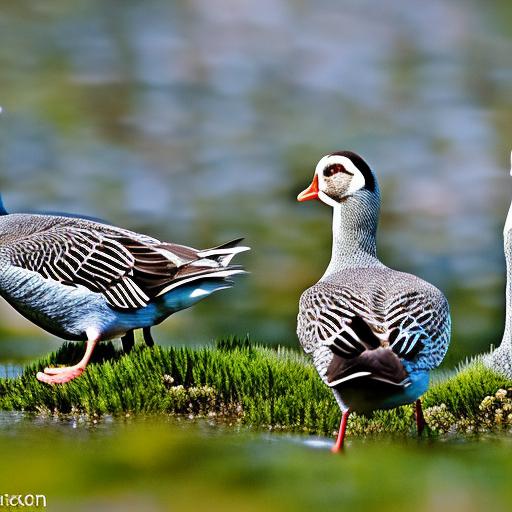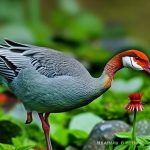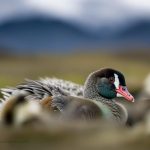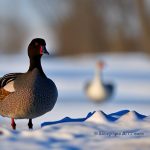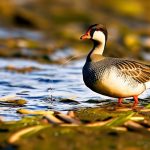Geese can be a beautiful sight to behold, but they can also be a nuisance when they invade your yard or garden. Their constant grazing can damage lawns and gardens, leaving behind unsightly droppings and destroying plants. Many homeowners are looking for effective and humane ways to deter geese from their property. One method that has gained popularity is the use of moth balls. In this article, we will explore the effectiveness of using moth balls to keep geese away and discuss the potential benefits and drawbacks of this method.
Key Takeaways
- Moth balls can be used to deter geese from yards and gardens
- Geese can be a nuisance due to their droppings and aggressive behavior
- Moth balls are effective in keeping geese away due to their strong odor
- The active ingredient in moth balls, naphthalene, affects the geese’s sense of smell and taste
- To use moth balls, place them strategically around the area you want to protect from geese.
- Safety considerations include keeping moth balls out of reach of children and pets
- Alternative methods for deterring geese include using decoys, noise makers, and physical barriers
- Common misconceptions include the idea that moth balls are harmful to geese or that they need to be ingested to be effective
- The environmental impact of using moth balls as a geese deterrent is minimal, but proper disposal is important
- Overall, using moth balls to deter geese can be effective, but it’s important to weigh the pros and cons and consider alternative methods.
Understanding the behavior of geese and why they can be a nuisance
Geese are social animals that often travel in large flocks. They are attracted to open spaces with ample food sources, such as grassy lawns and gardens. While they may seem harmless, geese can cause significant damage to yards and gardens. Their constant grazing can strip lawns of grass, leaving behind bare patches. They also have a voracious appetite for plants, often uprooting flowers and vegetables in gardens.
In addition to the physical damage they cause, geese droppings can also be a health hazard. Their droppings contain bacteria that can contaminate water sources and pose a risk to humans and pets. This is especially concerning if you have children or pets who spend time in your yard.
The effectiveness of moth balls in keeping geese away
Moth balls are small white balls made from either naphthalene or paradichlorobenzene, chemicals that have a strong odor that repels moths and other pests. The strong smell of moth balls is believed to deter geese as well. Many homeowners have reported success in using moth balls to keep geese away from their property.
One example of successful use of moth balls for geese control is placing them strategically around the perimeter of your yard or garden. Geese are creatures of habit and will often return to the same areas to graze. By placing moth balls in these areas, you can create a barrier that geese are reluctant to cross. Some homeowners have also reported success in hanging moth balls from trees or fences to deter geese from landing in their yard.
The science behind moth balls and their impact on geese
Moth balls are made from either naphthalene or paradichlorobenzene, both of which have a strong odor that repels pests. When exposed to air, these chemicals slowly vaporize and release a strong scent that is unpleasant to geese and other animals. The odor is believed to interfere with the geese’s ability to detect food sources and communicate with each other, making the area less attractive to them.
While moth balls can be effective in deterring geese, it is important to note that they can also be harmful to other animals and the environment. Moth balls are toxic if ingested and can cause serious health problems for pets and wildlife. They should be used with caution and kept out of reach of children and animals.
How to use moth balls to deter geese in your yard or garden
If you decide to use moth balls to deter geese, it is important to follow proper guidelines for their use. Here are some step-by-step instructions:
1. Purchase moth balls made from either naphthalene or paradichlorobenzene.
2. Determine the areas where geese are causing the most damage or where they frequently gather.
3. Place moth balls strategically around these areas, creating a barrier that geese are reluctant to cross.
4. If possible, hang moth balls from trees or fences to deter geese from landing in your yard.
5. Monitor the effectiveness of the moth balls and adjust their placement as needed.
It is important to note that the effectiveness of moth balls may vary depending on the specific circumstances and the behavior of the geese in your area. Some homeowners have reported success in using moth balls, while others have found them to be less effective. It may require some trial and error to find the best method for your situation.
Safety considerations when using moth balls around geese

While moth balls can be an effective deterrent for geese, it is important to consider the potential harm they can cause to humans and pets. Moth balls are toxic if ingested and can cause serious health problems if swallowed. They should be kept out of reach of children and animals.
When handling moth balls, it is important to wear gloves and avoid direct contact with the skin. If you accidentally come into contact with moth balls, wash your hands thoroughly with soap and water. It is also important to dispose of used moth balls properly. Do not throw them in the trash or flush them down the toilet. Instead, place them in a sealed container and dispose of them according to local regulations.
Alternative methods for deterring geese if moth balls don’t work
If you find that moth balls are not effective in deterring geese from your property, there are other methods you can try. One option is to use decoys, such as plastic owls or coyotes, to create the illusion of a predator in your yard. Geese are wary of predators and will often avoid areas where they are present.
Another option is to use noise makers, such as wind chimes or motion-activated sprinklers, to scare away geese. The sudden noise or movement can startle geese and make them reluctant to return to your yard.
It is important to note that these alternative methods may not be as effective as using moth balls, but they can be worth trying if you are not seeing the desired results.
Common misconceptions about using moth balls for geese control
There are some common misconceptions about using moth balls for geese control that should be addressed. One misconception is that moth balls are a guaranteed solution for keeping geese away. While many homeowners have reported success in using moth balls, they may not work in every situation. The effectiveness of moth balls can vary depending on the behavior of the geese in your area and the specific circumstances of your property.
Another misconception is that moth balls are completely safe for humans and pets. While they can be an effective deterrent for geese, moth balls are toxic if ingested and can cause serious health problems if swallowed. They should be used with caution and kept out of reach of children and animals.
The environmental impact of using moth balls as a geese deterrent
While moth balls can be effective in deterring geese, it is important to consider the potential harm they can cause to the environment. Moth balls are made from chemicals that can be toxic to wildlife and can contaminate water sources if not disposed of properly. It is important to follow proper guidelines for their use and disposal to minimize their impact on the environment.
If you are concerned about the environmental impact of using moth balls, there are eco-friendly alternatives you can try. For example, you can create a natural barrier around your yard or garden using plants that geese find unappealing, such as prickly shrubs or tall grasses. You can also use natural repellents, such as garlic or chili pepper spray, to deter geese from your property.
weighing the pros and cons of using moth balls to keep geese away
In conclusion, using moth balls to deter geese can be an effective method for keeping them away from your yard or garden. The strong odor of moth balls repels geese and makes the area less attractive to them. However, it is important to consider the potential harm they can cause to other animals and the environment. Moth balls are toxic if ingested and can contaminate water sources if not disposed of properly.
Before using moth balls or any other method for geese control, it is important to weigh the pros and cons and consider the specific circumstances of your property. It may require some trial and error to find the best method for your situation. If you are unsure, it is always a good idea to consult with a professional pest control expert who can provide guidance and advice tailored to your specific needs.
If you’re looking for effective ways to keep geese away from your property, you may have come across the suggestion of using moth balls. While this method is commonly mentioned, it’s important to understand its limitations and potential risks. In a related article on Poultry Wizard, they discuss alternative strategies for deterring geese and protecting your property. From exploring specialized fencing options to implementing natural deterrents like motion-activated sprinklers, this article provides valuable insights on how to effectively manage geese without relying solely on moth balls. To learn more about these strategies, check out the article here.
FAQs
What are moth balls?
Moth balls are small balls made of naphthalene or paradichlorobenzene that are used to repel moths and other insects from clothes and other stored items.
Can moth balls keep geese away?
There is no scientific evidence to suggest that moth balls can effectively repel geese. While some people claim that the strong odor of moth balls can deter geese, it is not a reliable or recommended method for keeping geese away.
Are moth balls safe to use around geese?
No, moth balls are not safe to use around geese or any other wildlife. The chemicals in moth balls can be toxic if ingested, and can also harm the environment if they are not disposed of properly.
What are some effective ways to keep geese away?
There are several effective ways to keep geese away, including using visual deterrents like scarecrows or reflective tape, using noise deterrents like loud noises or predator calls, and using physical barriers like fences or netting.
Why do people want to keep geese away?
People may want to keep geese away from their property or outdoor spaces because geese can be messy, aggressive, and can cause damage to lawns and gardens. Additionally, geese droppings can pose health risks to humans and pets.
Meet Walter, the feathered-friend fanatic of Florida! Nestled in the sunshine state, Walter struts through life with his feathered companions, clucking his way to happiness. With a coop that’s fancier than a five-star hotel, he’s the Don Juan of the chicken world. When he’s not teaching his hens to do the cha-cha, you’ll find him in a heated debate with his prized rooster, Sir Clucks-a-Lot. Walter’s poultry passion is no yolk; he’s the sunny-side-up guy you never knew you needed in your flock of friends!

